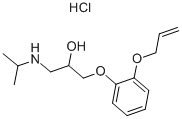Oxprenolol is an orally bioavailable β-adrenergic receptor (β-AR) antagonist (Ki = 7.10 nM in a radioligand binding assay using rat heart tissue). It is non-selective and binds to both β1- and β2-ARs (Kds = 2.09 and 1.35 nM in isolated rat heart and uterus, respectively). Oxprenolol is selective for β-ARs over serotonin (5-HT) receptors in rat sarcolemmal membrane preparations (IC50s = 4.13 and 23,300 nM, respectively), but it binds to 5-HT1A receptors in rat hippocampus and 5-HT1B in rat striatum (Kis = 94.2 and 642 nM, respectively). Formulations containing oxprenolol have been used to treat hypertension and angina pectoris.
Trasicor,Ciba Geigy ,Italy,1970
β-Adrenergic blocker. Antihypertensive, antianginal, antiarrhythmic.
Antihypertensive;Adrenergic receptor antagonist
75 grams of pyrocatechol monoallyl ether, 75 grams of epichlorohydrin, 75 grams of potassium carbonate and 400 ml of acetone are stirred and heated at the boil for 12 hours. The potassium carbonate is then filtered off. The solvent is distilled off in a water-jet vacuum. The residual oil is dissolved in ether and agitated with 2 N sodium hydroxide solution. The ether is separated, dried and distilled off. The residue is distilled in a water-jet vacuum. 3-(ortho-allyloxy-phenoxy)-1,2-epoxypropane passes over at 145° to 157°C under 11 mm Hg pressure. A solution of 15 grams of 3-(ortho-allyloxyphenoxy)-1,2-epoxypropane and 15 grams of isopropylamine in 20 ml of ethanol is refluxed for 4 hours. The excess amine and the alcohol are then distilled off under vacuum, to leave 1-isopropylamino-2-hydroxy-3-(orthoallyloxy-phenoxy)-propane which melts at 75° to 80°C after recrystallization from hexane.
Non-selective β -adrenergic antagonist.
Beta-1 adrenoceptor blocker:
Hypertension
Angina
Arrhythmias
Anxiety
Potentially hazardous interactions with other drugs
Anaesthetics: enhanced hypotensive effect.
Analgesics: NSAIDs antagonise hypotensive effect.
Anti-arrhythmics: increased risk of myocardial
depression and bradycardia; increased risk of
bradycardia, myocardial depression and AV block
with amiodarone; increased risk of myocardial
depression and bradycardia with flecainide.
Antidepressants: enhanced hypotensive effect with
MAOIs.
Antihypertensives: enhanced hypotensive effect;
increased risk of first dose hypotensive effect with
post-synaptic alpha-blockers such as prazosin;
increased risk of withdrawal hypertension with
clonidine; increased risk of bradycardia and AV
block with diltiazem; severe hypotension and heart
failure occasionally with nifedipine; asystole, severe
hypotension and heart failure with verapamil.
Antimalarials: increased risk of bradycardia with
mefloquine.
Antipsychotics: enhanced hypotensive effect with
phenothiazines.
Cytotoxics: possible increased risk of bradycardia
with crizotinib.
Diuretics: enhanced hypotensive effect.
Fingolimod: possibly increased risk of bradycardia.
Moxisylyte: possibly severe postural hypotension.
Sympathomimetics: severe hypertension with
adrenaline and noradrenaline (especially with non�selective beta-blockers) and possibly with dopamine.
Oxprenolol is extensively metabolised in the liver, direct
O-glucuronidation being the major metabolic pathway
and oxidative reactions minor ones. Oxprenolol is
excreted chiefly in the urine (almost exclusively in the
form of inactive metabolites).
